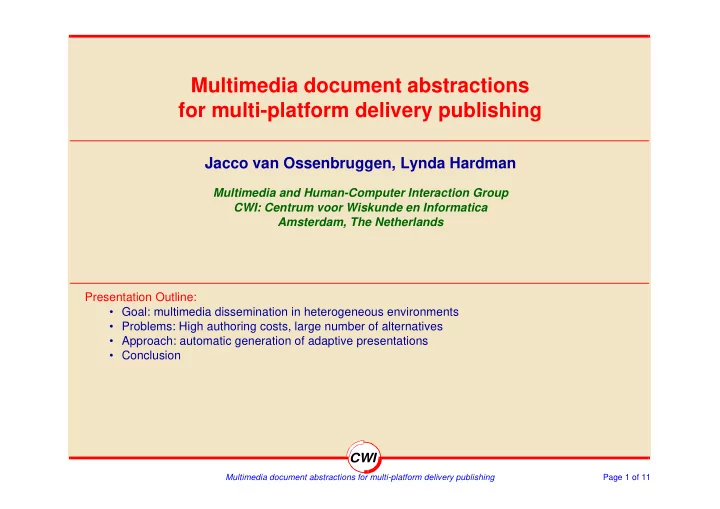

Multimedia document abstractions for multi-platform delivery publishing Jacco van Ossenbruggen, Lynda Hardman Multimedia and Human-Computer Interaction Group CWI: Centrum voor Wiskunde en Informatica Amsterdam, The Netherlands Presentation Outline: • Goal: multimedia dissemination in heterogeneous environments • Problems: High authoring costs, large number of alternatives • Approach: automatic generation of adaptive presentations • Conclusion CWI Multimedia document abstractions for multi-platform delivery publishing Page 1 of 11
Goal: Ubiquitous on-line multimedia services Requirements for document and authoring process model: • Dissemination to multiple platforms — High-end multimedia PCs, graphical workstations — Laptops, palmtops, PDAs — Mobile phones, smartphones — TV set-top boxes — etc • Cost-effective and timely generation of multimedia presentations — automate authoring process — take platform/network characteristics into account — take user’s knowledge, experience and task into account • Just-in-time multimedia presentation adaptation — support authoring with incomplete information — some information is only available during run-time Multimedia document abstractions for multi-platform delivery publishing Page 2 of 11
Approach (1) Adaptable versus adaptive documents: • adaptable documents: — multiple delivery publishing model used in electronic publishing • adaptive documents: — explicit user models, task models, platform specifications Both approaches can be used together: • adaptable documents: — adaptation during authoring/generation time — focus: document abstractions • adaptive documents: — run-time adaptation — focus: alternate content Multimedia document abstractions for multi-platform delivery publishing Page 3 of 11
Approach (2) Many models/tools are useful for both approaches • document abstractions — from output medium/layout (structured document models in electronic publishing) — from system/network resources (QoS models in multimedia) — from users (tutoring models in adaptive hypermedia) • tools for generating multiple presentations from a single source — markup languages, style sheets etc Multimedia document abstractions for multi-platform delivery publishing Page 4 of 11
Document abstractions (1) source document target presentation Multimedia document abstractions for multi-platform delivery publishing Page 5 of 11
Document abstractions (2) source presentations Multimedia document abstractions for multi-platform delivery publishing Page 6 of 11
Document abstractions (3) In hypermedia: what is content, what is structure and what is style? • Coarse-grained temporal alignment (e.g. par , seq ) • Fine-grained temporal alignment (e.g. begin , end , dur ) • Hyperlinking ( a , anchor ) • Basic spatial layout (e.g. regions ) • Alternate content (e.g. switch ) • Transitions (not in SMIL) • Background colors, anchor styles, etc (not in SMIL) Which aspects of the document are likely to vary when different presentations are used? When do you have sufficient information? • authoring • rendering • presentation Multimedia document abstractions for multi-platform delivery publishing Page 7 of 11
Alternate content (1) Currently based on explicit encoding of alternate content E.g. the switch element in SMIL • At most one of the children of a switch element is played. • The first acceptable element is chosen, so ordering should be best first. <switch> <audio system-bitrate=”44000” src=”hi-res.aiff” /> <audio system-bitrate=”16000” src=”low-res.aiff” /> </switch> • If no element is suitable then no child of the switch is played. A catch-all choice at the end of the switch (with no test attribute) could be used. Multimedia document abstractions for multi-platform delivery publishing Page 8 of 11
Alternate content (2) SMIL test attributes: • system-bitrate - specifies available network bandwidth. • system-captions - allows authors to supply subtitles, for those with hearing difficulties or learning a language. • system-language - denotes the intended language group. • system-overdub-or-caption - selects between dubbing or subtitles. Can also be used with the system-captions attribute. • system-required - This will be an XML namespace in future versions. • system-screen-size - height x width in pixels • system-screen-depth - gives the depth of screen color palette the player is able to display.Switch on bitrate and language Multimedia document abstractions for multi-platform delivery publishing Page 9 of 11
Alternate content (3) Combinatorial explosion on the leaf-nodes of the document hierarchy: <switch> <audio system-bitrate=”44000” system-language=”nl” src=”nl-hi-res.aiff” /> <audio system-bitrate=”44000” system-language=”en” src=”uk-hi-res.aiff” /> <audio system-bitrate=”16000” system-language=”nl” src=”nl-low-res.aiff” /> <audio system-bitrate=”16000” system-language=”en” src=”uk-low-res.aiff” /> </switch> Multimedia document abstractions for multi-platform delivery publishing Page 10 of 11
Conclusions Two-step adaptation: • adaptation in presentation generation process (multiple delivery publishing) • adaptation in presentation output format (alternate content) Multiple delivery publishing: • models and tools still text-oriented • in hypermedia, the boundary between content, structure, style is fuzzy • alternate content may lead to a combinatorial explosion on the leaf-node level Multimedia document abstractions for multi-platform delivery publishing Page 11 of 11
Recommend
More recommend